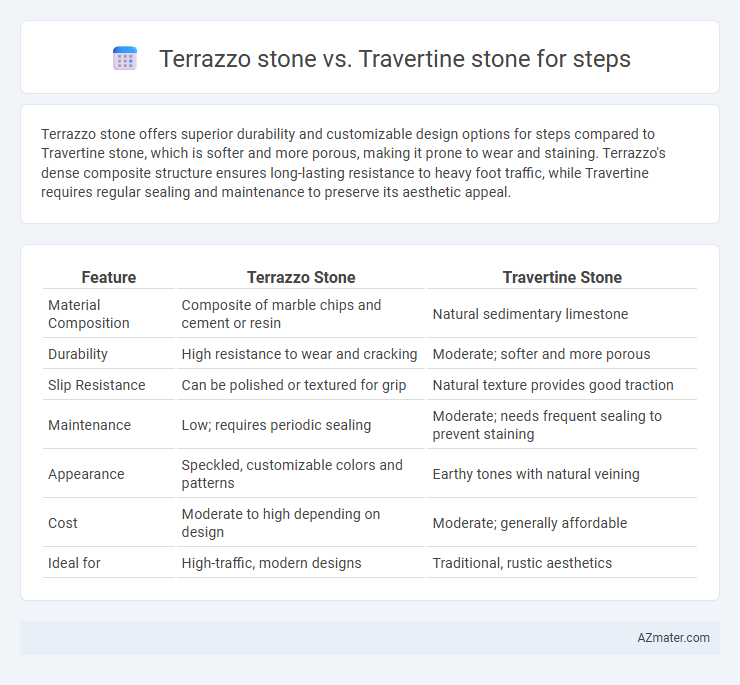Terrazzo stone offers superior durability and customizable design options for steps compared to Travertine stone, which is softer and more porous, making it prone to wear and staining. Terrazzo's dense composite structure ensures long-lasting resistance to heavy foot traffic, while Travertine requires regular sealing and maintenance to preserve its aesthetic appeal.
Table of Comparison
| Feature | Terrazzo Stone | Travertine Stone |
|---|---|---|
| Material Composition | Composite of marble chips and cement or resin | Natural sedimentary limestone |
| Durability | High resistance to wear and cracking | Moderate; softer and more porous |
| Slip Resistance | Can be polished or textured for grip | Natural texture provides good traction |
| Maintenance | Low; requires periodic sealing | Moderate; needs frequent sealing to prevent staining |
| Appearance | Speckled, customizable colors and patterns | Earthy tones with natural veining |
| Cost | Moderate to high depending on design | Moderate; generally affordable |
| Ideal for | High-traffic, modern designs | Traditional, rustic aesthetics |
Understanding Terrazzo Stone: Composition and Characteristics
Terrazzo stone is a composite material consisting of chips of marble, quartz, granite, or glass embedded in a cement or epoxy resin binder, offering exceptional versatility and durability for steps. Its non-porous surface resists stains and moisture, making it ideal for high-traffic areas where slip resistance and long-lasting performance are critical. Compared to travertine, terrazzo provides a more customizable design palette and enhanced strength due to its engineered composition.
What is Travertine Stone? Properties and Origins
Travertine stone, a natural limestone formed by mineral springs, is widely recognized for its porous texture and earthy color palette, including shades of cream, tan, and rust. Originating primarily from regions such as Italy, Turkey, and Mexico, travertine boasts durability and a slip-resistant surface, making it suitable for steps and outdoor applications. Its naturally pitted surface can be honed or filled, providing both aesthetic appeal and functional safety for stair installations.
Durability: Terrazzo vs Travertine for Steps
Terrazzo stone exhibits exceptional durability for steps due to its composite nature of marble or glass chips embedded in cement or epoxy, resulting in high resistance to wear, impact, and moisture. Travertine stone, while aesthetically appealing with its natural porous texture, is comparatively softer and more prone to scratching, staining, and weathering under heavy foot traffic. For steps subjected to frequent use and exposure, terrazzo offers a longer-lasting, low-maintenance surface compared to travertine.
Aesthetic Appeal: Design Options Compared
Terrazzo stone offers a highly customizable design palette with its blend of marble, quartz, glass, or other aggregates, allowing for vibrant colors and intricate patterns ideal for unique step aesthetics. Travertine stone presents a natural, earthy appeal with its warm tones and subtle veining, providing a classic and timeless look for steps. Both materials enhance the visual impact of staircases, with terrazzo delivering bold, modern designs and travertine offering rustic elegance.
Slip Resistance and Safety on Staircases
Terrazzo stone offers superior slip resistance on staircases due to its dense, non-porous composition and polished finish that can be treated with anti-slip coatings, making it safer for high-traffic areas. Travertine stone, while aesthetically appealing with natural textures, has a more porous surface prone to becoming slippery when wet unless specifically honed or filled and sealed. For optimal staircase safety, terrazzo's durability and customizable slip-resistant options provide a distinct advantage over travertine in minimizing slip hazards.
Maintenance Needs: Terrazzo versus Travertine Steps
Terrazzo steps require less maintenance due to their highly durable and non-porous surface, which resists stains and moisture effectively. Travertine steps, composed of natural limestone with porous textures, demand regular sealing to prevent water damage and staining. Cleaning terrazzo involves simple damp mopping, whereas travertine requires specialized cleaners to maintain its appearance and avoid surface erosion.
Cost Comparison: Terrazzo Stone vs Travertine Stone
Terrazzo stone generally costs between $20 and $60 per square foot, making it a more budget-friendly option compared to travertine, which ranges from $30 to $70 per square foot. Installation costs for terrazzo can be higher due to the labor-intensive process, but its durability and low maintenance often offset these expenses over time. Travertine stone requires sealing and periodic maintenance, increasing its long-term costs despite the lower initial installation price.
Installation Process: Which Stone is Easier for Steps?
Terrazzo stone offers a smoother installation process on steps due to its pre-cast slabs and uniform thickness, allowing for precise fitting and minimal surface preparation. Travertine stone requires more skilled labor for cutting and leveling because of its natural porosity and variable thickness, which can complicate the installation process on step edges. Overall, terrazzo is easier and faster to install for steps compared to travertine.
Environmental Impact and Sustainability Factors
Terrazzo stone, composed of recycled glass, marble chips, and cement, offers a highly sustainable option for steps due to its use of recycled materials and longevity, reducing waste and the need for frequent replacements. Travertine stone, a natural sedimentary rock, involves quarrying processes that can cause significant environmental disruption and higher carbon emissions, although it remains biodegradable and durable. Choosing terrazzo can significantly lower ecological footprints in step construction by minimizing raw material extraction and supporting circular economy principles.
Best Applications: Choosing Between Terrazzo and Travertine for Steps
Terrazzo stone offers superior durability and uniform appearance, making it ideal for high-traffic indoor steps requiring low maintenance and design flexibility. Travertine stone, with its natural porous texture and warm, earthy tones, is best suited for outdoor steps or areas emphasizing rustic aesthetics but may require sealing to enhance durability. Selecting between Terrazzo and Travertine for steps depends on the desired balance between style, durability, and maintenance needs.

Infographic: Terrazzo stone vs Travertine stone for Step
 azmater.com
azmater.com